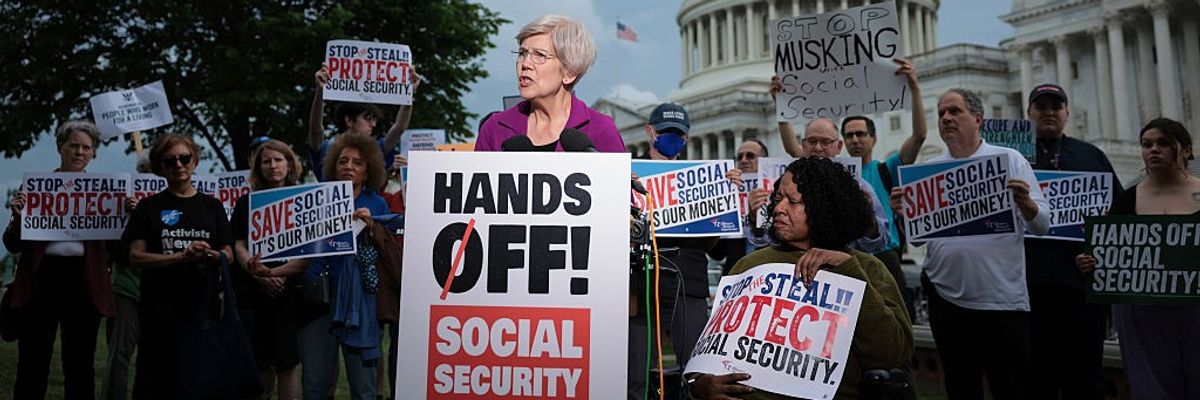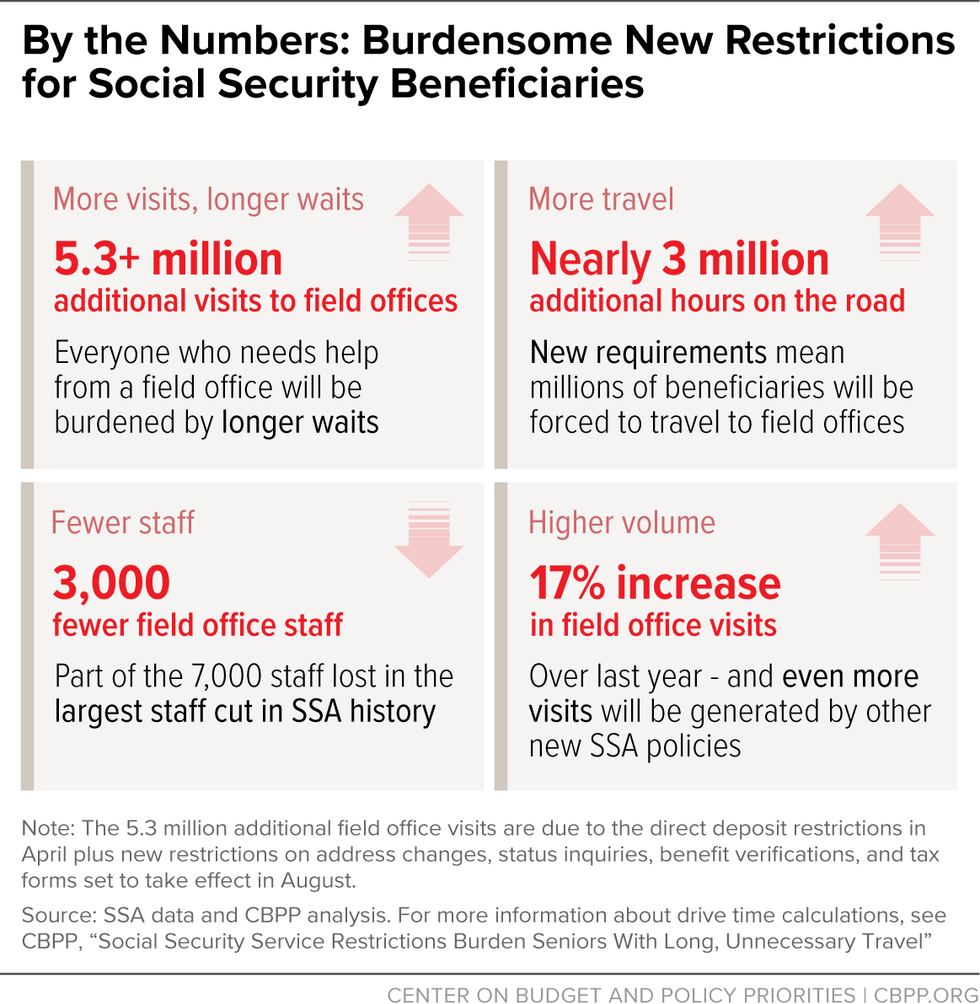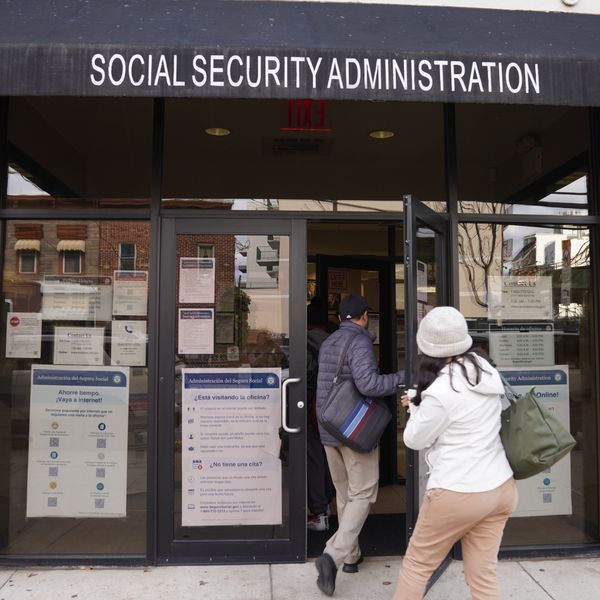
U.S. Sen. Elizabeth Warren (D-Mass.) speaks during a press conference on Social Security in front of the U.S. Capitol on May 5, 2025, in Washington, D.C.
Looming Trump Policy May Mean Longer Wait Times for Millions of Social Security Recipients
Beginning in mid-August, Trump's Social Security Administration will no longer allow seniors to perform many routine tasks related to their benefits over the phone, as they have been able to do for decades.
U.S. President Donald Trump's Social Security Administration is rolling out a new policy next month that is expected to further increase wait times for basic services.
Beginning in mid-August, the SSA will no longer allow seniors to perform many routine tasks related to their benefits over the phone, as they have been able to do for decades.
In order to do things like change their addresses, check the status of claims, request benefit verification letters, or ask for tax forms, they will soon need to perform a complicated multifactor online verification process.
As a report published Tuesday by the Center on Budget and Policy Priorities (CBPP) points out:
The new PIN code process will be impossible for many beneficiaries to complete. And if they can't, they'll need to travel to a field office. That will require 3.4 million more people to travel to SSA offices annually, by the agency's own estimates. This will create a significant new burden, particularly for those who live in rural areas or have transportation or mobility difficulties.
CBPP estimated that the restrictions on phone service will result in seniors spending an additional 3 million combined hours traveling to Social Security offices each year.
A previous policy change rolled out in April has already forbidden recipients from using the phone to change their bank account information, which the SSA revealed would require 2 million more people to make in-person visits each year.
The new restrictions to be rolled out next month, the administration's numbers say, will force another 3.4 million people to travel to the offices.

Once they reach the office, their waits are also likely to increase. Social Security offices around the country are already increasingly overburdened due to massive cuts to staff by the Department of Government Efficiency (DOGE) earlier this year.
Nearly 2,000 field office staff took buyouts offered by Elon Musk—who stated his goal to "eliminate" Social Security altogether—and an undisclosed additional number either took early retirements or left.
According to an investigation by the office of Sen. Elizabeth Warren (D-Mass.), these cuts have also increased wait times for phone calls by a hour and 45 minutes on average.
The administration is also now relying on an artificial intelligence program to answer phone calls, which callers have described as "maddening" to use. A Washington Post reporter who tested the system in May found that it struggled repeatedly to answer her basic query about not receiving her check and needing to speak to an agent.
(Video: MSNBC)
Another 1,000 field office staff were reassigned to answer phones in early July after phone lines became overwhelmed following earlier workforce cuts.
While it remains to be seen what effect this will have on call response times, it is expected that this will only exacerbate the increased wait times for in-person services, which will become more heavily burdened due to the new requirements.
Last week, Kathleen Romig, a former SSA official who's now the director of Social Security and disability policy at CBPP, described it as "a deep hole of their own creation," as SSA's cuts meant "you just don't have enough people to go around to serve the public." She said increasing call staff by poaching from already understaffed field offices was like trying to "rearrange the deck chairs on the Titanic."
Warren, meanwhile, has accused the SSA of fudging numbers to downplay long wait times. The administration has claimed its wait times are as low as 12 minutes. But when Warren's office tested the call lines in June, it took an average of 102 minutes for calls to be answered—over 8.5 times longer than what the agency claimed—while more than half were not answered by a human at all.
"The SSA is failing to provide policymakers and the public with accurate information about the extent of the problem, using convoluted calculations to obfuscate the real data, or withholding information entirely," Warren said Tuesday.
In a letter sent Friday to SSA Commissioner Frank Bisignano, Warren pressed for him to provide "a thorough and expeditious evaluation of wait times for key Social Security services" in compliance with an audit requested by the agency's inspector general.
According to Warren, Bisignano committed to the audit in a meeting between the two, but it was not specified when it would take place.
In the meantime, the issue of long wait times is likely to only grow worse, as the Trump administration plans to eliminate a total of 7,000 employees from the administration by the end of the fiscal year.
Romig and CBPP senior fellow Devin O'Connor wrote Tuesday that "millions of beneficiaries will start to be affected" by the new restrictions on phone calls "within a matter of weeks."
"SSA did not consult with stakeholders before rushing to make this switch," they continued, "and it has yet to announce or explain the change to Social Security beneficiaries, instead burying notice of the change in a technical notice on a regulatory website."
"The agency," they said, "has provided no clear justification for the change other than vaguely citing 'fraud risk,' despite there being no publicly documented problems with completing any of these tasks by phone."
An Urgent Message From Our Co-Founder
Dear Common Dreams reader, The U.S. is on a fast track to authoritarianism like nothing I've ever seen. Meanwhile, corporate news outlets are utterly capitulating to Trump, twisting their coverage to avoid drawing his ire while lining up to stuff cash in his pockets. That's why I believe that Common Dreams is doing the best and most consequential reporting that we've ever done. Our small but mighty team is a progressive reporting powerhouse, covering the news every day that the corporate media never will. Our mission has always been simple: To inform. To inspire. And to ignite change for the common good. Now here's the key piece that I want all our readers to understand: None of this would be possible without your financial support. That's not just some fundraising cliche. It's the absolute and literal truth. We don't accept corporate advertising and never will. We don't have a paywall because we don't think people should be blocked from critical news based on their ability to pay. Everything we do is funded by the donations of readers like you. Will you donate now to help power the nonprofit, independent reporting of Common Dreams? Thank you for being a vital member of our community. Together, we can keep independent journalism alive when it’s needed most. - Craig Brown, Co-founder |
U.S. President Donald Trump's Social Security Administration is rolling out a new policy next month that is expected to further increase wait times for basic services.
Beginning in mid-August, the SSA will no longer allow seniors to perform many routine tasks related to their benefits over the phone, as they have been able to do for decades.
In order to do things like change their addresses, check the status of claims, request benefit verification letters, or ask for tax forms, they will soon need to perform a complicated multifactor online verification process.
As a report published Tuesday by the Center on Budget and Policy Priorities (CBPP) points out:
The new PIN code process will be impossible for many beneficiaries to complete. And if they can't, they'll need to travel to a field office. That will require 3.4 million more people to travel to SSA offices annually, by the agency's own estimates. This will create a significant new burden, particularly for those who live in rural areas or have transportation or mobility difficulties.
CBPP estimated that the restrictions on phone service will result in seniors spending an additional 3 million combined hours traveling to Social Security offices each year.
A previous policy change rolled out in April has already forbidden recipients from using the phone to change their bank account information, which the SSA revealed would require 2 million more people to make in-person visits each year.
The new restrictions to be rolled out next month, the administration's numbers say, will force another 3.4 million people to travel to the offices.

Once they reach the office, their waits are also likely to increase. Social Security offices around the country are already increasingly overburdened due to massive cuts to staff by the Department of Government Efficiency (DOGE) earlier this year.
Nearly 2,000 field office staff took buyouts offered by Elon Musk—who stated his goal to "eliminate" Social Security altogether—and an undisclosed additional number either took early retirements or left.
According to an investigation by the office of Sen. Elizabeth Warren (D-Mass.), these cuts have also increased wait times for phone calls by a hour and 45 minutes on average.
The administration is also now relying on an artificial intelligence program to answer phone calls, which callers have described as "maddening" to use. A Washington Post reporter who tested the system in May found that it struggled repeatedly to answer her basic query about not receiving her check and needing to speak to an agent.
(Video: MSNBC)
Another 1,000 field office staff were reassigned to answer phones in early July after phone lines became overwhelmed following earlier workforce cuts.
While it remains to be seen what effect this will have on call response times, it is expected that this will only exacerbate the increased wait times for in-person services, which will become more heavily burdened due to the new requirements.
Last week, Kathleen Romig, a former SSA official who's now the director of Social Security and disability policy at CBPP, described it as "a deep hole of their own creation," as SSA's cuts meant "you just don't have enough people to go around to serve the public." She said increasing call staff by poaching from already understaffed field offices was like trying to "rearrange the deck chairs on the Titanic."
Warren, meanwhile, has accused the SSA of fudging numbers to downplay long wait times. The administration has claimed its wait times are as low as 12 minutes. But when Warren's office tested the call lines in June, it took an average of 102 minutes for calls to be answered—over 8.5 times longer than what the agency claimed—while more than half were not answered by a human at all.
"The SSA is failing to provide policymakers and the public with accurate information about the extent of the problem, using convoluted calculations to obfuscate the real data, or withholding information entirely," Warren said Tuesday.
In a letter sent Friday to SSA Commissioner Frank Bisignano, Warren pressed for him to provide "a thorough and expeditious evaluation of wait times for key Social Security services" in compliance with an audit requested by the agency's inspector general.
According to Warren, Bisignano committed to the audit in a meeting between the two, but it was not specified when it would take place.
In the meantime, the issue of long wait times is likely to only grow worse, as the Trump administration plans to eliminate a total of 7,000 employees from the administration by the end of the fiscal year.
Romig and CBPP senior fellow Devin O'Connor wrote Tuesday that "millions of beneficiaries will start to be affected" by the new restrictions on phone calls "within a matter of weeks."
"SSA did not consult with stakeholders before rushing to make this switch," they continued, "and it has yet to announce or explain the change to Social Security beneficiaries, instead burying notice of the change in a technical notice on a regulatory website."
"The agency," they said, "has provided no clear justification for the change other than vaguely citing 'fraud risk,' despite there being no publicly documented problems with completing any of these tasks by phone."
- Trump administration's Social Security changes could limit access to ... ›
- Press Release | Press Office | SSA ›
- FACT SHEET: Trump and Musk's Plot to Make It Harder for ... ›
- Press Release | Press Office | SSA ›
- Threats to the Social Security Administration and to Benefits ... ›
- Social Security Announces 2.5 Percent Benefit Increase for 2025 | SSA ›
- Social Security Announces Expedited Retroactive Payments and ... ›
- Downsizing Staff Will Make It Harder to Receive Social Security ... ›
U.S. President Donald Trump's Social Security Administration is rolling out a new policy next month that is expected to further increase wait times for basic services.
Beginning in mid-August, the SSA will no longer allow seniors to perform many routine tasks related to their benefits over the phone, as they have been able to do for decades.
In order to do things like change their addresses, check the status of claims, request benefit verification letters, or ask for tax forms, they will soon need to perform a complicated multifactor online verification process.
As a report published Tuesday by the Center on Budget and Policy Priorities (CBPP) points out:
The new PIN code process will be impossible for many beneficiaries to complete. And if they can't, they'll need to travel to a field office. That will require 3.4 million more people to travel to SSA offices annually, by the agency's own estimates. This will create a significant new burden, particularly for those who live in rural areas or have transportation or mobility difficulties.
CBPP estimated that the restrictions on phone service will result in seniors spending an additional 3 million combined hours traveling to Social Security offices each year.
A previous policy change rolled out in April has already forbidden recipients from using the phone to change their bank account information, which the SSA revealed would require 2 million more people to make in-person visits each year.
The new restrictions to be rolled out next month, the administration's numbers say, will force another 3.4 million people to travel to the offices.

Once they reach the office, their waits are also likely to increase. Social Security offices around the country are already increasingly overburdened due to massive cuts to staff by the Department of Government Efficiency (DOGE) earlier this year.
Nearly 2,000 field office staff took buyouts offered by Elon Musk—who stated his goal to "eliminate" Social Security altogether—and an undisclosed additional number either took early retirements or left.
According to an investigation by the office of Sen. Elizabeth Warren (D-Mass.), these cuts have also increased wait times for phone calls by a hour and 45 minutes on average.
The administration is also now relying on an artificial intelligence program to answer phone calls, which callers have described as "maddening" to use. A Washington Post reporter who tested the system in May found that it struggled repeatedly to answer her basic query about not receiving her check and needing to speak to an agent.
(Video: MSNBC)
Another 1,000 field office staff were reassigned to answer phones in early July after phone lines became overwhelmed following earlier workforce cuts.
While it remains to be seen what effect this will have on call response times, it is expected that this will only exacerbate the increased wait times for in-person services, which will become more heavily burdened due to the new requirements.
Last week, Kathleen Romig, a former SSA official who's now the director of Social Security and disability policy at CBPP, described it as "a deep hole of their own creation," as SSA's cuts meant "you just don't have enough people to go around to serve the public." She said increasing call staff by poaching from already understaffed field offices was like trying to "rearrange the deck chairs on the Titanic."
Warren, meanwhile, has accused the SSA of fudging numbers to downplay long wait times. The administration has claimed its wait times are as low as 12 minutes. But when Warren's office tested the call lines in June, it took an average of 102 minutes for calls to be answered—over 8.5 times longer than what the agency claimed—while more than half were not answered by a human at all.
"The SSA is failing to provide policymakers and the public with accurate information about the extent of the problem, using convoluted calculations to obfuscate the real data, or withholding information entirely," Warren said Tuesday.
In a letter sent Friday to SSA Commissioner Frank Bisignano, Warren pressed for him to provide "a thorough and expeditious evaluation of wait times for key Social Security services" in compliance with an audit requested by the agency's inspector general.
According to Warren, Bisignano committed to the audit in a meeting between the two, but it was not specified when it would take place.
In the meantime, the issue of long wait times is likely to only grow worse, as the Trump administration plans to eliminate a total of 7,000 employees from the administration by the end of the fiscal year.
Romig and CBPP senior fellow Devin O'Connor wrote Tuesday that "millions of beneficiaries will start to be affected" by the new restrictions on phone calls "within a matter of weeks."
"SSA did not consult with stakeholders before rushing to make this switch," they continued, "and it has yet to announce or explain the change to Social Security beneficiaries, instead burying notice of the change in a technical notice on a regulatory website."
"The agency," they said, "has provided no clear justification for the change other than vaguely citing 'fraud risk,' despite there being no publicly documented problems with completing any of these tasks by phone."
- Trump administration's Social Security changes could limit access to ... ›
- Press Release | Press Office | SSA ›
- FACT SHEET: Trump and Musk's Plot to Make It Harder for ... ›
- Press Release | Press Office | SSA ›
- Threats to the Social Security Administration and to Benefits ... ›
- Social Security Announces 2.5 Percent Benefit Increase for 2025 | SSA ›
- Social Security Announces Expedited Retroactive Payments and ... ›
- Downsizing Staff Will Make It Harder to Receive Social Security ... ›

